“They taste great with a beer”, I had been asking a few friends about their experiences with cicadas and this strange response was not what I was expecting, but there is much about the cicada that is strange and unexpected (the same could be said about some of my friends).
For many people around the world (and wildlife too) the cicada is a valued source of protein. The friend who was suggesting them as a good accompaniment to a beer had just returned from living in Laos, where cicadas are commonly eaten and are considered easy to prepare. Apparently all you have to do is pull the wings and legs off and then drop them in a wok of hot oil. In the Western MacDonnell Ranges in Central Australia there are stories of how Aboriginal children used to collect the newly emerged adults for the old people to eat.
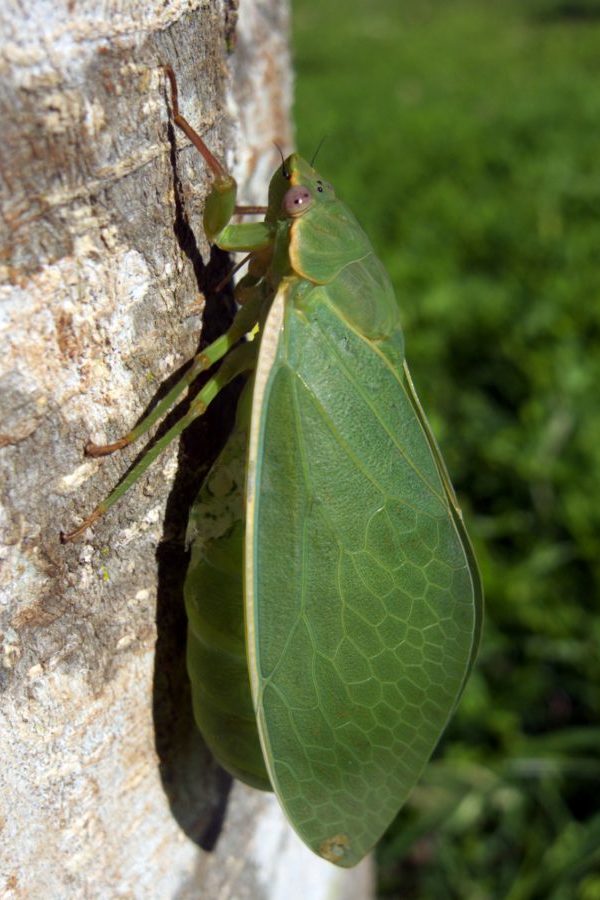
Forewing length: 38-51 mm.
Adults most active: November to January.
Typical location: Shrubs and small trees in gardens, rainforest and grazing land close to the ground. Lantana is also commonly utilised. Singing males are difficult to locate due to their cryptic coloration, even though most can be found within easy reach. They are also attracted to light.
Call: A very low pitched, guttural growl or ‘r’ continued for up to 1½ hours at dusk into early nightfall. The song is not completely continuous and has momentary pauses.
Photo by Todd Burrows.
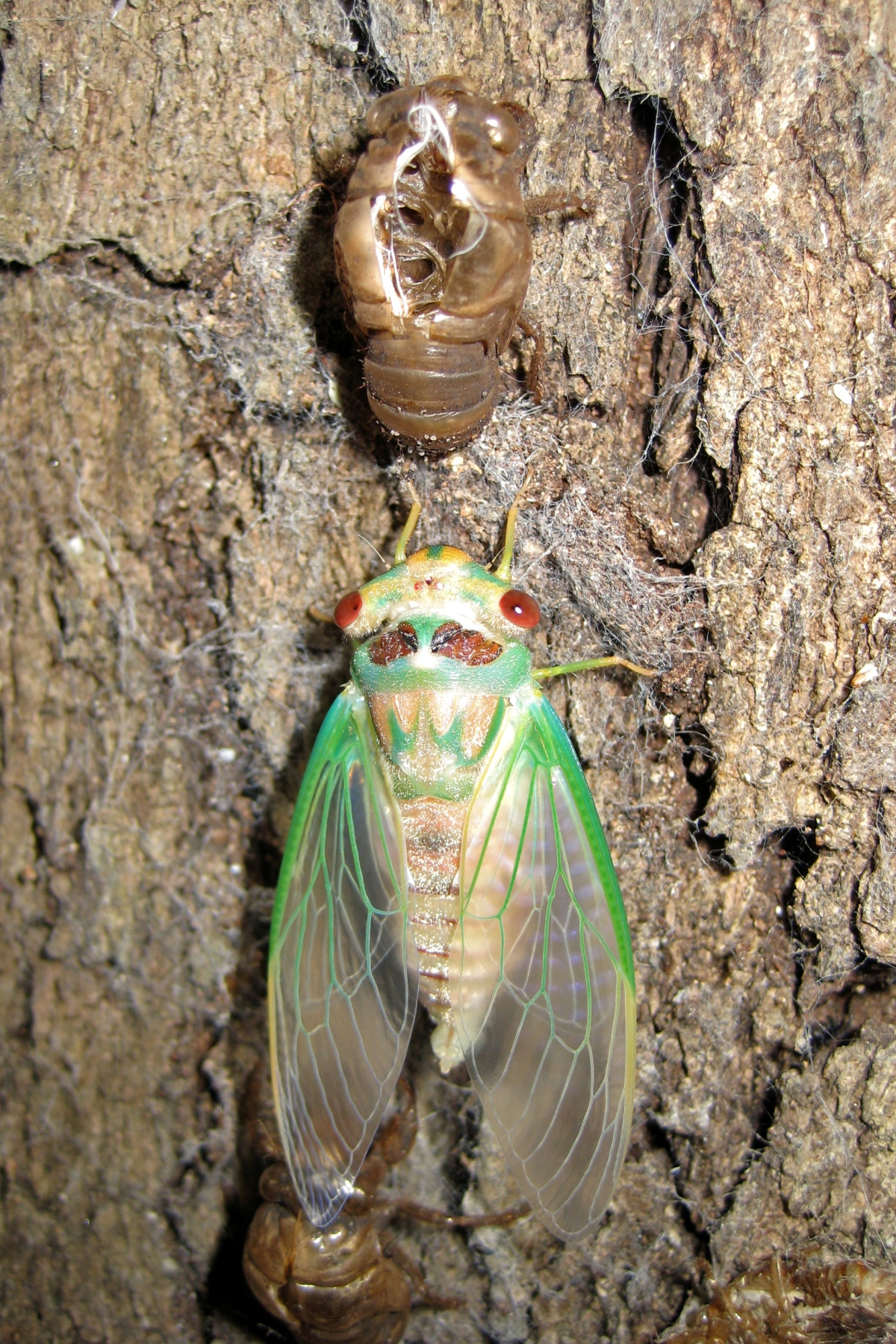
Forewing length: 34-42 mm.
Adults most active: Late December and during January.
Typical location: Common in suburban Brisbane and across SEQ. They are usually found on casuarinas, angophoras and eucalypts in dry open forest sometimes congregating together in large numbers in just a few trees.
Call: “A strong rattle that builds up before bursting into a rapid pulsing song. It then returns to the rattle and the process repeats, sounding something like a large sprinkler system.” L.W. Popple.
Photo by Todd Burrows.
Cicadas are and have been an important introduction to nature for Australian children for generations. You only have to contemplate the visually evocative common names of Australian cicadas to understand this; some local examples are Floury Baker, Cherrynose and Double Drummer. So it is no surprise to discover that some of these names were made by children over 100 years ago.
Much of the myth and mystery of the cicada comes from its extraordinary lifecycle. The 1.5–3 mm eggs are laid into a series of slits cut by the female’s ovipositor in anything from the branch of a tree or shrub to the stem of a grass or herb both living and dead. In two to seven months the eggs hatch and the tiny nymphs drop to the ground and quickly search for a crack or crevice to avoid desiccation or predation.
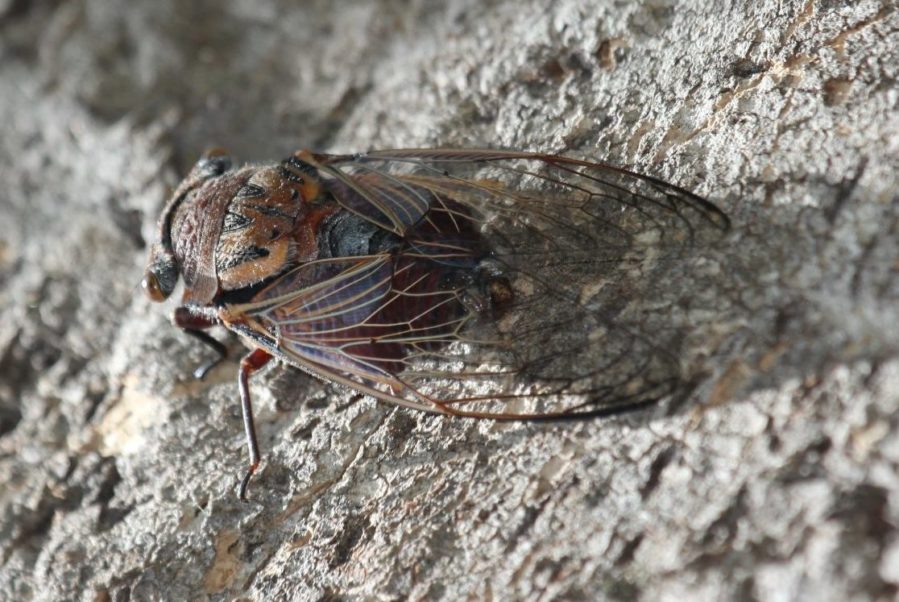
Forewing length: 50-66 mm – Australia’s largest cicada.
Adults most active: November to early March. In some years they will be very common, while others almost absent.
Typical location: Common across SEQ. Adults form large local aggregations on trunks of large Eucalypts in dry sclerophyll forest.
Call: Moulds evocative description, “Particularly loud, somewhat drone-like in nature, resembling the high pitched whine of a bagpipe with momentary fluctuations and breaks. When populations are large the noise is almost unbearable to be near.”
Photo by Deborah Metters.
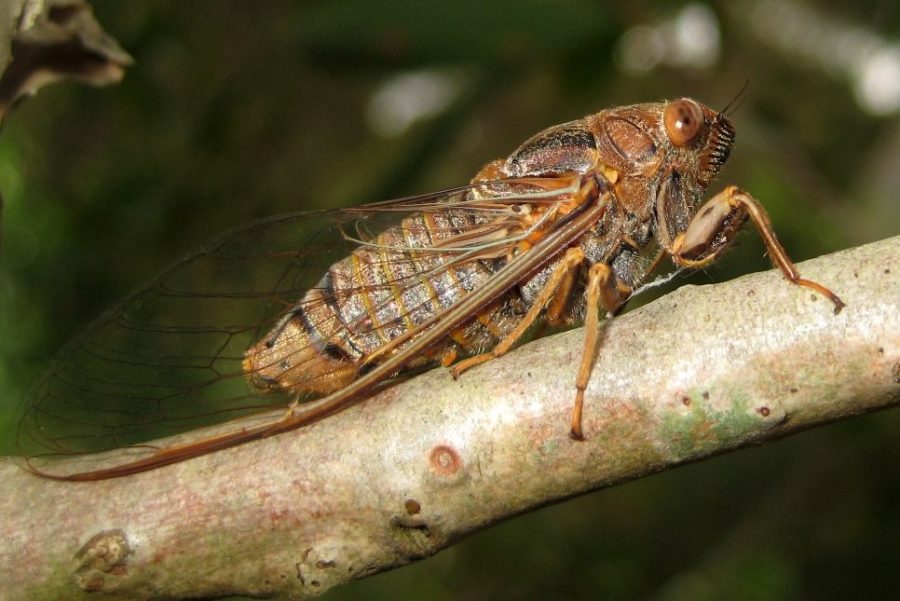
Forewing length: 24-32 mm.
Adults most active: August to March but most commonly from October to December.
Typical location: Found across SEQ usually in dry sclerophyll forest but also open woodland and parkland.
Call: “A repeated series of nasal phrases “quack quack quack quack” produced just prior to take-off and whilst in flight” L.W. Popple.
Photo by Todd Burrows.
Once underground they will tunnel in search of a suitable location to excavate a cavity beside a plant root, on which they can feed. As they grow they will moult several times and may also need to move to find a new plant root to feed on. The exact time spent underground for most Australian cicadas is unknown, one of the exceptions is the Greengrocer (Cyclochilae australasiae) that has a nymphal stage of about seven years. The lifecycles of American cicadas are much better known and have nymphal stages lasting 13 and 17 years.
Most people’s experience of the nymphal stage is limited to the empty dried brown skin found on tree trunks, grass stems and fence posts. The emergence of the adult from the nymphal skin takes more than an hour and usually occurs during the first few hours of darkness on a warm evening after rain. Once free of the nymphal skin the wings are pumped full of a greenish watery fluid called haemolymph to expand them, which is then withdrawn to allow them to dry and strengthen.
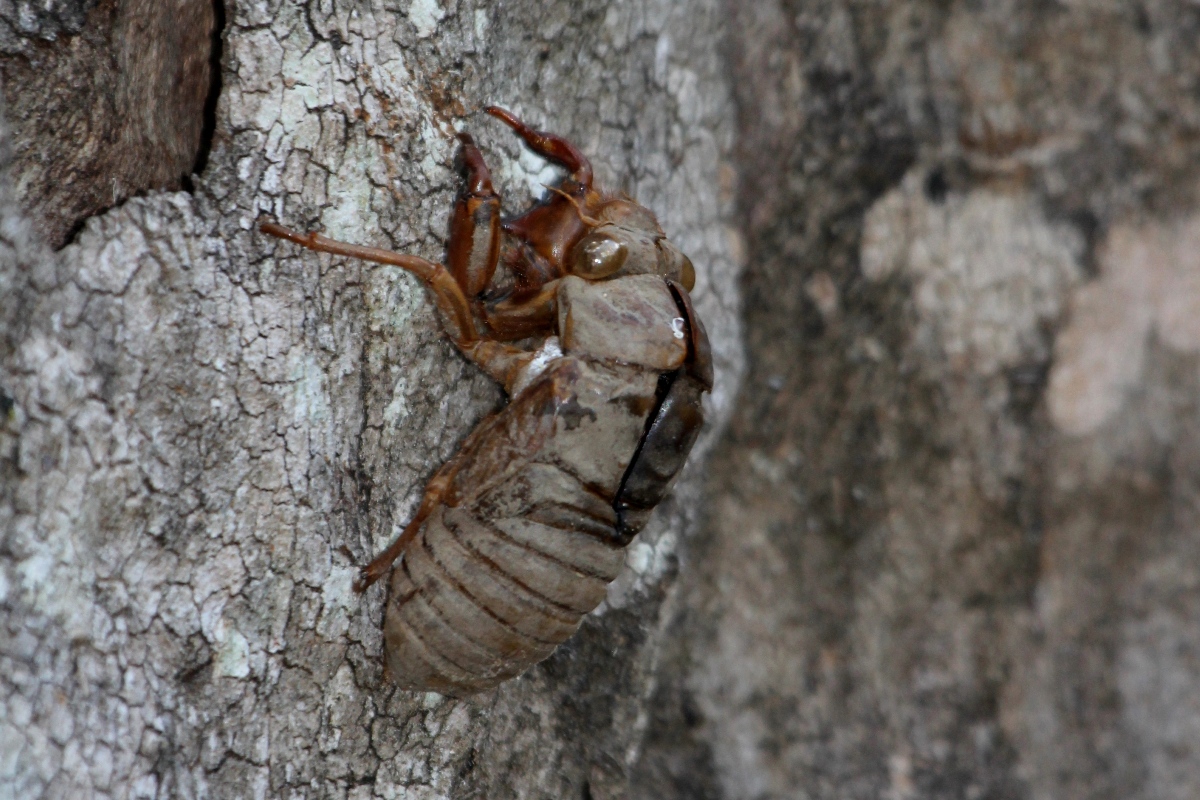
The song of the cicada is a remarkable thing. And for me, more than any other sound, the song of the cicada is the sound of summer in Australia. The Greengrocer is reputedly the loudest insect on the planet at nearly 120 decibels and the Double Drummer is pretty close to that. Put a few hundred in a tree all calling at once and the noise is not far off the pain threshold.
There are other species of cicada that produce calls of such high frequency and low intensity that they are almost inaudible to the human ear. Some sing during the day, others at dusk and some at both times. However all cicada calls are temperature dependent, that is they will not commence calling until air temperature reaches a certain threshold for their species and it will cease once it drops below that threshold. Only the males call and its primary purpose is to attract a female, though some species have a separate distinct distress call.
I haven’t revealed all the secrets of the cicada here, there just isn’t enough space. If you are interested in finding out more, check out Lindsay Popple’s excellent website.
Article by Alan Wynn, Land for Wildlife Officer, Sunshine Coast Council
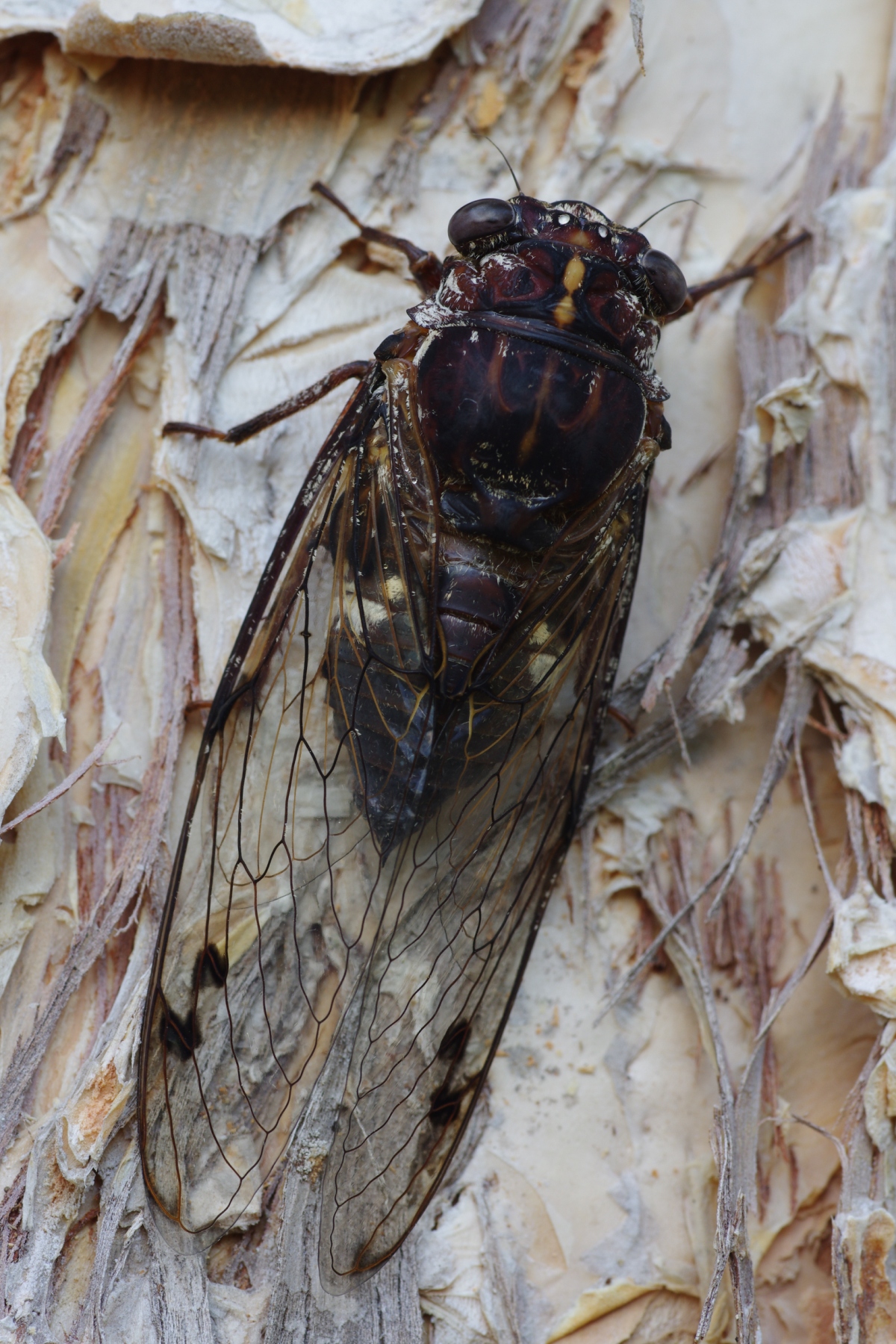
Forewing length: 33-51 mm.
Adults most active: Mid-December to January.
Typical location: Common in suburban areas throughout SEQ. Adapted to a wide variety of habitats and plant species but appear to show preference for paperbarks (melaleucas) and bottlebrushes (callistemons). They are usually found facing downwards on branches.
Call: “A loud hiss-like series of phrases that rapidly accelerate into a continuous hiss (shhh, shhh, shhh, shhh, shhh, shhh, shhh, shhh, shhh, shh shh shh-sh-sh-sh-sh-h-h-h-h-h-h-h-h-h-h-h-h-h…). This call is emitted during the day. At dusk a continuous hissing song is produced” L.W. Popple.
Photo by Alan Wynn.
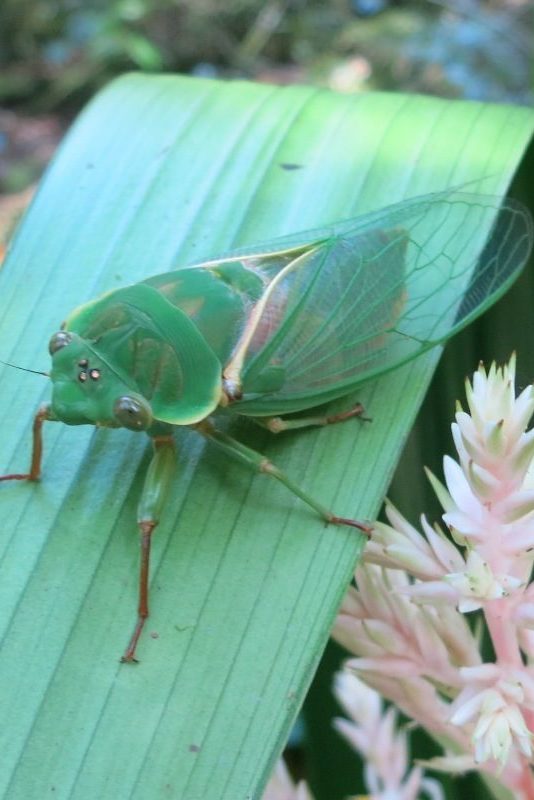
Forewing length: 50-58 mm.
Adults most active: October to January, with highest numbers occurring in November and early December.
Colour variants: The Greengrocer comes in many different colours, from a yellow form (Yellow Monday) to a tan form, red form and a rare blue form.
Typical location: In SEQ it is usually found at altitudes above 300 m in dry and wet sclerophyll forests, for example Mt Glorious, Mt Nebo, occasionally Mt Tamborine and into the Granite belt.
Call: A continuous, harsh, loud call with a mild fluctuation in its volume, occasionally fragmented into a regular succession of short sound bursts. At close range the volume approaches 120 decibels, nearing the pain threshold of the human ear.
Photo by Ceris Ash, Springbrook Wildlife Appreciation Group.

44 waldron court wamuran q 4512
Found on the euodia
Say 10 crawling up the tree
Able to grab one
Now in container poor thing
2 cm long
Opaque black wings
Fawn coloured eyes
Green body
Dark glossy green
Thought a fly
Or beetle
Now at 1 AM
Searching cicadas
Museum of q book of wildlife and google
Been here 20 years and have noted several species over that time
I came to ask the same thing. I took photos. Light beige eyes, turquoise just under the eyes, black head and thorax with an iridescent emerald green abdomen.
Approximate length 5cm.
Southport 4215
Southport